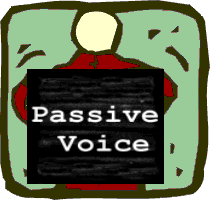Table of Contents
What Is Passive Voice?
Here’s a simple definition of the passive voice:
Passive voice is a grammatical construction where the subject of a sentence receives the action of the verb instead of performing it. This structure emphasizes the action or the recipient, often leaving the doer unspecified.
Passive Voice Examples
- Without the doer:
- The report was submitted. (Focus: the report, not the one who sent it.)
- The package was delivered. (Focus: the package, not the delivery person.)
- Mistakes were made. (No blame assigned.)
- With the doer (optional):
- They were invited to the party (by the host).
- The house is being cleaned (by the maid).
Note:
In passive constructions, the “by” phrase is only included if the doer is important. Most passive sentences omit it.
Active Voice vs. Passive Voice

The primary distinction between active and passive voice in English lies in the role of the subject. In active voice, the subject performs the action, while in passive voice, it receives the action. Consider the following example:
- Active Voice: The subject performs the action.
- Example: “The teacher gave them enough time.” (Focus: the teacher doing the action.)
- Passive Voice: The subject receives the action.
- Example: “They were given enough time.” (Focus: the recipients, not who gave the time.)
Here is a table explaining the difference between the passive and active voice:
| Active Voice (Subject Acts) | Passive Voice (Subject Receives) |
|---|---|
| The chef cooked the meal. | The meal was cooked by the chef. |
| Scientists conducted the experiment. | The experiment was conducted by scientists. |
Key Difference: In passive constructions, the object of the active sentence becomes the subject.
Examples of Active and Passive Voice In English
| Active Voice | Passive Voice |
|---|---|
| Most countries in Latin America speak Spanish. | Spanish is spoken in most countries in Latin America. |
| William Shakespeare wrote “Hamlet.” | “Hamlet” was written by William Shakespeare. |
| Scientists conducted the experiment in a controlled environment. | The experiment was conducted in a controlled environment by scientists. |
| Someone had stolen the car. | The car had been stolen. |
| Most people believe that the earth is round. | Most people believe that the Earth is round. |
| The intern has written the report. | The report has been written by the intern. |
| The company is hiring a new employee. | A new employee is being hired by the company. |
How to Construct the Passive Voice (Step-by-Step)
1. Passive Voice Construction Rules
The passive voice follows this formula:
Subject + [form of “to be”] + [past participle] + (optional “by” phrase)
The appropriate form of to be is based on the tense of the active voice main verb:
- Active: The team completed the project. (“Completed” is in the simple past.)
- Passive: The project was completed (by the team). (“Was” is the simple past of to be + completed” is in the simple past.)
Grammar Tip: The form of “to be” in passive voice always matches the tense of the active verb.
- Active (Present Perfect): They have finished the work. → Passive: The work has been finished.
2. Steps to Convert Active to Passive:
- Identify the object of the active sentence → becomes the subject of the passive sentence.
- Add the correct form of “to be” (match the original tense).
- Use the past participle of the main verb.
- Optionally add “by [agent]” if the doer is important.
3. Examples of Active and Passive Constructions:
| Active Tense | Active | “To Be” Form + Past Participle | Passive |
|---|---|---|---|
| Present Simple | She reads the book daily. | am/is/are + read | The book is read daily. |
| Past Simple | He sent the report. | was/were + sent | The report was sent. |
| Present Continuous | They are building a school. | am/is/are being + built | A school is being built. |
| Past Continuous | They baked the cake. | was/were being + baked | The cake was being baked. |
| Present Perfect | He has taken notes. | has/have been + written | Notes have been taken. |
| Past Continuous | They had served dinner. | had been + served | Dinner had been served. |
| Future Simple | We will provide help. | will be + provided | Help will be provided. |
When to Use Passive Voice Construction
Passive voice is used when the focus is on the action, and it is not crucial or known who or what performs the action. For instance, “A letter was written” emphasizes the act of writing without specifying the writer.
- Emphasizing the action or recipient: Passive voice is used when the focus is on the action. It is not important who or what is performing the action.
- Example: “A letter was written.”
The focus, here, is on the fact that a letter was written. We don’t know, however, who wrote it.
- Example: “A letter was written.”
- The doer is unknown/unimportant: It is also used when we don’t know the doer of the action.
- Example: “My bike was stolen.”
- To be less accusative: Sometimes, a statement in passive voice is more polite (or less accusative) than in active voice, as the following example shows:
- Example: “A vase was broken.”
The focus, here, is on the fact that a vase was broken, but we don’t blame anyone. Compare this to: “You broke the vase.”
- Example: “A vase was broken.”
- Formal or scientific writing: It is used when we want to appear more objective.
- Example: “The experiment was conducted in a controlled environment.” (More objective tone.)
(For the use of the passive structure in writing, click here)
Examples of the Passive Voice
Here are examples of passive construction across tenses:
| Tense | Subject | Verb | Object | |
|---|---|---|---|---|
| Simple Present | Active: | Nancy | makes | tea. |
| Passive: | Tea | is made | by Nancy. | |
| Present Progressive | Active: | Nancy | is making | tea. |
| Passive: | Tea | is being made | by Nancy. | |
| Simple Past | Active: | Nancy | made | tea. |
| Passive: | Tea | was made | by Nancy. | |
| Past Progressive | Active: | Nancy | was making | tea. |
| Passive: | Tea | was being made | by Nancy. | |
| Present Perfect | Active: | Nancy | has made | Tea. |
| Passive: | Tea | has been made | by Nancy. | |
| Past Perfect | Active: | Nancy | had made | tea. |
| Passive: | Tea | had been made | by Nancy. | |
| Future simple | Active: | Nancy | will make | tea. |
| Passive: | Tea | will be made | by Nancy. | |
| Future perfect | Active: | Nancy | will have made | tea. |
| Passive: | Tea | will have been made | by Nancy. | |
| Conditional | Active: | Nancy | would make | tea. |
| Passive: | Tea | would be made | by Nancy. | |
| Modals | Active: | Nancy | can make | tea. |
| Passive: | Tea | can be made | by Nancy. | |
Advanced Passive Constructions
1. Passive Voice Sentences with Two Objects
When transforming an active sentence with two objects into a passive structure, one object becomes the subject, and the other remains an object. The choice depends on what you wish to emphasize.
- Active: Nancy offered a flower to me.
- Passive: A flower was offered to me (by Nancy).
- Alternative Passive: I was offered a flower (by Nancy).
2. Impersonal Passive Voice
In the impersonal passive voice, sentences begin with the subject of the that-clause and use the impersonal form “it is…” This is applicable primarily with verbs of perception (e.g., say, think, know).
Examples of passive impersonal constructions:
- They say that the planet is in danger.
- It is said that the planet is in danger.
- It is thought that the planet is in danger.
- It is believed that the planet is in danger.
- It is known that the planet is in danger.
It’s also common to initiate the passive form with the subject of the that-clause:
- They say that the planet is in danger.
- The planet is said to be in danger.
3. Passive Voice with Infinitives or Gerunds
In addition to the standard structure of passive voice using past participles, passive constructions can also involve infinitives. This occurs when the action is described as necessary, obligatory, or required. Here’s an example:
- Example: You have to be informed.
In this sentence, “You have to be informed” is in the passive voice with an infinitive. Let’s break it down:
- Active Voice: Someone (not specified) informs you.
- Passive structure with Infinitive: You have to be informed.
In this construction, the infinitive “to be informed” is used to express the passive voice. It conveys a sense of obligation or necessity for the subject to receive the action of being informed. This structure is often employed when emphasizing the importance of the action or the responsibility of the subject to be informed.
It’s worth noting that passive voice with infinitives is particularly common in instructions, rules, or situations where compliance or necessity is underscored. This usage highlights the action that needs to be taken without explicitly stating who will perform the action.
Example Sentences:
- Active Voice: The manager informs the team about the changes.
- Passive Voice with Infinitive: The team has to be informed about the changes.
- Active Voice: The authorities will announce the decision.
- Passive structure with Infinitive: The decision will have to be announced.
- Active Voice: The teacher advises the students to send the assignment by email.
- Passive structure with Infinitive: The students need to be advised to send the assignment by email.
In each of these examples, the passive voice with infinitives is used to emphasize the necessity or obligation for the subject to undergo the action. This construction is a useful tool when clarity and emphasis on responsibility are crucial in communication.
4. Passive Voice with Gerunds
Passive constructions can also involve gerunds when describing an action that someone experiences or undergoes. Gerunds, ending in “-ing,” are used to convey activities or actions as nouns. When combined with the passive voice, they emphasize the experience or reception of an action rather than who is performing it.
Let’s explore this concept with an example:
- Example: She recalls being bullied by her classmates.
In this sentence, “being bullied” is a phrase that involves a gerund in a passive construction. Here’s a breakdown:
- Active: Her classmates bully her.
- Passive with Gerund: She recalls being bullied by her classmates.
In this construction, the gerund “being bullied” conveys that she is the recipient of the action, emphasizing the experience rather than the individuals carrying out the bullying. Passive constructions with gerunds are effective when the focus is on the impact or effect of an action on the subject.
Example Sentences:
- Active Voice: The team mocked him during the presentation.
- Passive Voice with Gerund: He remembers being mocked during the presentation.
- Active Voice: They are praising her for solving the problem.
- Passive Voice with Gerund: She appreciates being praised for solving the problem.
- Active Voice: The audience admired his performance.
- Passive Voice with Gerund: His performance was admired by the audience.
In each instance, the passive structure with gerunds shifts the focus to the experience or impact of the action on the subject. This construction is particularly useful when the emphasis is on the emotional or psychological effect of an action, providing a nuanced perspective on the events described.
FAQs about Passive constructions in English
What tense is used in passive voice?
The passive voice uses the appropriate form of the verb “to be” (matching the tense of the active voice main verb) along with the past participle of the main verb.
Is passive voice bad?
Using passive voice is a stylistic choice; it’s not inherently wrong grammatically. However, it’s often discouraged due to its tendency to create unclear and wordy sentences compared to the simplicity of active voice.
Is passive voice formal or informal?
It is sometimes considered formal, particularly in contexts where objectivity is valued, such as scientific texts.
When to use the passive voice?
Passive voice is used to sound more formal or professional in specific contexts. It’s also used to appear less accusative or to avoid assigning blame or responsibility.
More on passive structures here.
Conclusion
The passive is a grammatical structure wherein the subject receives the action rather than performing it. It is used when the doer is unknown, to convey objectivity, or to maintain a less accusative tone. This structure finds frequent use in scientific texts or news stories.
Key Takeaways
- Passive voice construction shifts focus from the doer to the action/recipient.
- Follow the formula: Subject + [to be] + [past participle].
- Use it strategically—not by default.
Related Pages


